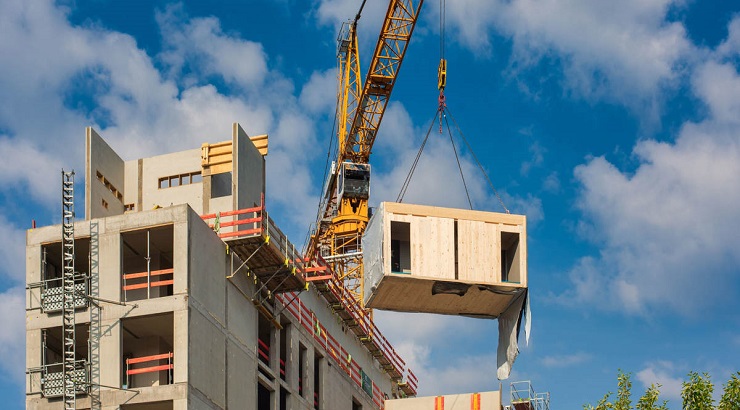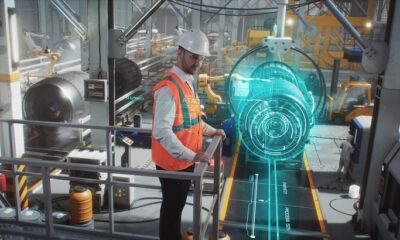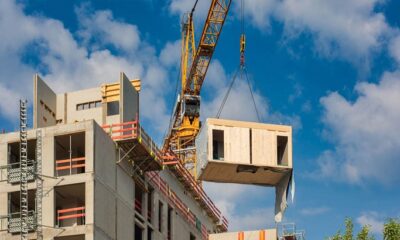Innovation
The A to Z of Modular Construction
The first instance of modular construction came in the 1830s.

What’s modular construction?
Modular construction is a construction method where a building is constructed off-site in a factory setting before being transported to the site for assembly.
In this mode of construction, building components are prefabricated in a factory as separate modules or units. The modules are then shipped to the construction site and assembled together to form the final structure.
This helps cut the construction timeline by up to 50%.
Modular construction has recently gained popularity due to its benefits in terms of efficiency, cost-effectiveness, and quality control.
It is particularly useful for projects that require faster completion times and can be applied to various types of buildings, ranging from residential to commercial.
When did modular construction start?
Although modular construction has gained popularity recently, it has been in existence for many years.
Indeed, the first recorded case of modular construction emerged in the 1930s, when a British carpenter named John Manning prefabricated a house for his son. This house was built in parts before being shipped to Australia for assembly.
During the 1840s California Gold Rush, modular construction enjoyed significant popularity. It was used for the construction of the iconic ‘Crystal Palace’ for Britain’s Great Exhibition of 1851.
It further gained traction through the creation of prefabricated structures during and after the Second World War.
How does modular construction work?
Modular buildings are manufactured in separate sections away from the construction site and later shipped to the desired location for assembly.
This process involves completing a significant portion (60–90%) of the construction in a factory, either as a complete structure or as modular subassemblies for large projects.
The use of off-site construction allows for the implementation of efficient lean manufacturing techniques to create high-quality prefabricated modules.
On the construction site, these modules are interconnected using inter-module connections to securely link the units together, creating a unified building.
RELATED: America’s 10 Finest Prefabricated Homes
Permanent modular buildings are designed to meet, if not exceed, the same standards as traditional site-built houses, thereby ensuring stringent quality control and high levels of craftsmanship.
Can modular homes be moved?
Yes, one of the key benefits of modular homes is their ability to be moved. However, it is important to note that not all modular buildings can be moved. Only the specific type known as ‘relocatable’ buildings is designed for relocation.
On the other hand, some modular homes are designed to be permanently placed on a foundation and are not intended for relocation. These types of houses, once assembled and fixed to a foundation, are not meant to be moved.
To further explore this topic, let’s explore the two types of modular construction.
Types of modular construction
There are two types of modular construction: Relocatable Building (RB) and Permanent Modular Construction (PMC).
Relocatable Building – RBs are designed to be reused or repurposed multiple times at various sites. They are ideal for schools, construction site offices, medical clinics, and any other situations that require temporary space solutions.
These buildings are designed to offer effortless relocation, inexpensive reconfiguration, faster depreciation schedules, and outstanding adaptability.
Unlike permanent structures, relocatable buildings are not permanently fixed to real estate but are installed in accordance with the manufacturer’s installation guidelines and local building codes.
Permanent Modular Construction – PMC is a sustainable construction method utilizing offsite, lean manufacturing techniques to prefabricate single- or multi-story buildings in deliverable module sections.
PMC modules provide a permanent solution as they can be seamlessly integrated into site-built projects or stand alone as self-contained, fixed structures.
These modules are delivered with MEP (mechanical, electrical, and plumbing), fixtures, and interior finishes in a short timeframe.
This approach helps to minimize wastage of materials while ensuring better quality control compared to projects relying on conventional building methods.
Is modular construction cheaper?
Numerous studies have shown that modular construction can yield significant cost savings when compared with traditional on-site construction.
This benefit is linked to factors such as the limited influence of weather on project schedules and the opportunity to work on the structures offsite, resulting in reduced material waste.
However, it is worth noting that the extent of these savings can vary depending on specific project characteristics, location, and design complexity, among other factors.
It is advisable to conduct a detailed cost analysis based on your project’s specific requirements to decide whether modular construction is the best option for you.
Is modular construction sustainable?
Yes, modular construction is considered a sustainable building method due to its efficiency and reduced material waste.
The energy efficiency of factory-based construction helps lower energy consumption, making modular construction an eco-friendly option.
RELATED: 10 Construction Industry Trends to Watch This Year
Besides, this mode of construction promotes sustainability through minimized site disturbance and transportation efficiency with modular construction.
Pros and cons of modular construction
Modular construction presents a plethora of advantages over traditional construction techniques. These include:
- Faster construction: Modules can be manufactured before onsite preparations, speeding up the entire build process.
- Reduced material waste: Material supplies are better controlled in the factory, leading to less waste and a lower environmental impact.
- Enhanced quality and comfort: Factory conditions enable higher quality products, while employees work in a more comfortable environment.
- Efficient insulation: Many modular units use Structural Insulated Panels, which offer improved thermal insulation, damp and cold resistance compared to materials like timber. Factory construction reduces moisture levels inside the building, enhancing product quality.
- Flexibility: Modular structures can be easily expanded over time or treated as relocatable buildings, ready for overhaul to meet new needs.
- Suitable for remote locations: Modular construction is ideal for remote areas where onsite building may be challenging or costly.
- No weather delays: Construction delays due to adverse weather and onsite issues are eliminated as the modules are manufactured in a factory.
- Durability: Modular units must meet regulations for travel and assembly, resulting in a product that is more durable than a traditional building.
- Time and cost savings: Modular construction saves 30–50% of construction time compared to traditional methods, leading to substantial cost savings.
With that in mind, it is worth noting that modular construction does come with its own set of challenges. Two of the primary challenges include:
- Logistical hurdles: Transporting finished modules to the construction site requires careful planning and coordination, which can be expensive.
- Size limitations: The manufacturing and transportation processes may impose restrictions on the size of each modular unit. This can have implications on the size of rooms within the building, potentially affecting the overall design.
However, despite these challenges, modular construction remains a viable option for many projects, offering a range of solutions that continue to evolve with time.












